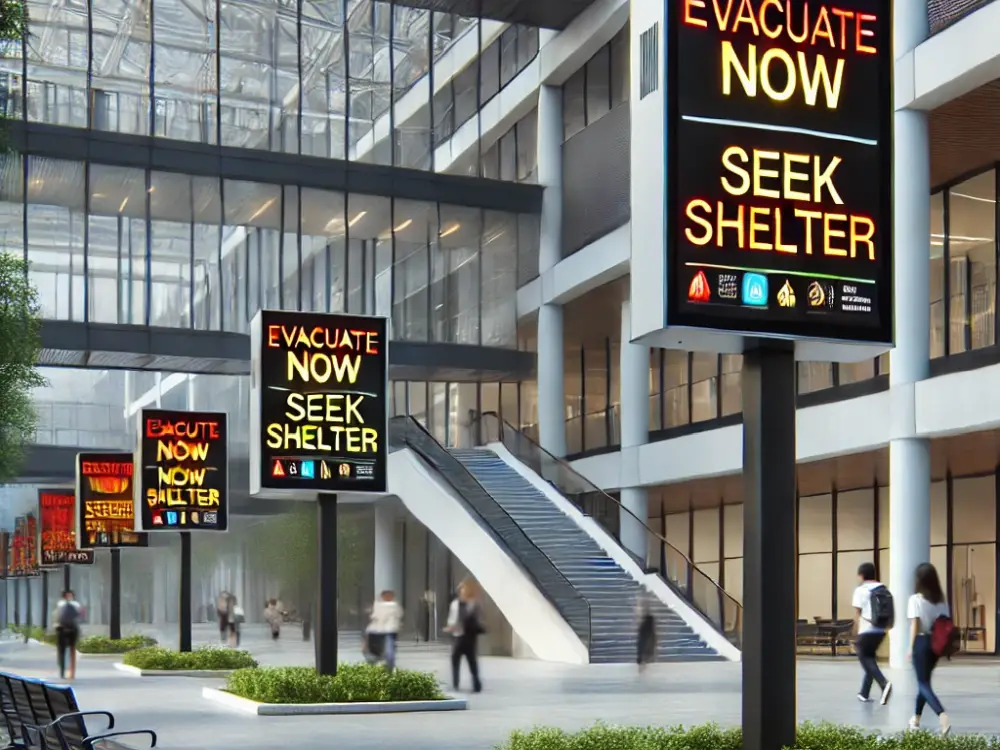How to Use Digital Signage for Campus Safety and Emergency Alerts
Digital signage is transforming communication across educational institutions, becoming an essential tool for campus safety and emergency alert systems. These digital displays provide timely and clear messages, making campuses more prepared for both everyday safety protocols and unexpected emergencies.

Enhancing Safety Across Campuses
Educational institutions often have large and dispersed campuses, making it challenging to maintain consistent communication. By deploying digital displays, schools and universities can deliver real-time updates across various buildings and outdoor areas. This technology helps ensure that all individuals on campus are aware of ongoing safety measures and potential threats.

Real-Time Emergency Alerts
One of the primary advantages of digital displays is their ability to broadcast urgent alerts instantly, making them indispensable during emergencies. These screens can be programmed to display various types of alerts, including:
- Evacuation Orders: In situations such as fires, gas leaks, or chemical spills, evacuation orders can be displayed immediately, guiding students and staff to the safest exits.
- Severe Weather Warnings: Digital signage can provide real-time updates about impending severe weather, such as storms, tornadoes, or heavy rainfall, allowing campuses to take necessary precautions.
- Lockdown Protocols: In the unfortunate event of a security threat, digital displays can communicate lockdown instructions, guiding individuals on how to secure themselves safely within buildings.
Assisting with Evacuations
Digital signage systems are particularly effective in assisting with campus evacuations. During a crisis, clear and visible instructions are crucial to prevent confusion and panic. Digital displays can show evacuation routes, helping people identify the nearest exits and find safe pathways. Additionally, some advanced digital systems use AI to adjust the instructions based on real-time data, such as blocked exits or overcrowded areas.
Daily Safety Communication
Beyond emergency situations, digital signage can enhance daily campus safety through routine communication:
- Health Reminders: Displays can promote health-related messages, such as reminders to wash hands, maintain social distancing, or use sanitizers during flu seasons.
- General Safety Tips: Screens can also be used to display safety tips related to personal security, fire safety, or proper handling of equipment in labs and workshops.
- Awareness Programs: Institutions can use digital signage to run awareness campaigns on mental health, substance abuse prevention, and first-aid training, encouraging a culture of safety among students and staff.

Integrating with Campus Security Systems
When integrated with existing campus security infrastructure, digital signage becomes even more powerful. For instance:
- CCTV and Surveillance Alerts: By connecting with campus surveillance systems, digital displays can issue alerts about suspicious activities or unauthorized access to restricted areas.
- Access Control Notifications: Digital signage at entry points can display guidelines for visitors, ensuring adherence to access protocols.
- Fire Alarm Connectivity: Integrated digital screens can display evacuation instructions automatically when a fire alarm is triggered, providing clear guidance on the nearest exits.
Advantages of Using Digital Signage
Implementing digital displays for campus safety offers numerous advantages:
- Instant Communication: Digital displays can be updated remotely and rapidly, making them ideal for delivering time-sensitive information.
- Wide Visibility: Placed strategically, these large screens ensure safety messages are visible to the campus population, regardless of their location.
- Multi-Language Support: To cater to diverse student bodies, digital displays can show messages in multiple languages, ensuring that alerts are understood by everyone on campus.
- Remote Management: Campus security personnel can manage the content displayed from a central location, ensuring timely updates and relevant messages.
Implementation Tips for Digital Displays
If you are considering digital signage for your campus safety program, here are some implementation tips:
- Identify Key Locations: Place digital displays in high-traffic areas such as building entrances, cafeterias, libraries, and dormitory lobbies. This ensures that safety messages reach a large audience quickly.
- Update Content Regularly: Make sure that safety messages, evacuation routes, and emergency contacts are frequently updated to reflect current guidelines.
- Conduct Regular Drills: Use digital signage during safety drills to familiarize students and staff with how the system operates in real emergencies.
- Offer Training for Staff: Train staff members to manage and update the digital signage system effectively, so they can handle communications in emergency situations.
The Future of Digital Signage in Education
The use of digital signage is expected to evolve further with advancements in AI, IoT, and cloud computing. Future digital displays might incorporate features such as facial recognition for real-time security alerts, interactive screens for direct communication, and predictive analytics to identify potential risks before they escalate. By investing in digital signage, educational institutions not only improve immediate safety but also position themselves as forward-thinking organizations committed to creating safer learning environments.
Conclusion
In conclusion, digital signage serves as a critical component in modern campus safety strategies. Its versatility, rapid deployment, and broad visibility make it an indispensable tool for educational institutions aiming to enhance safety protocols. As campuses become more digitized, integrating digital displays into safety strategies is not just an option—it’s a necessity.
By leveraging this technology, schools and universities can ensure better communication, faster emergency response times, and a safer overall environment for students, faculty, and visitors.


